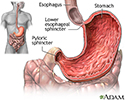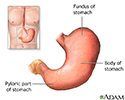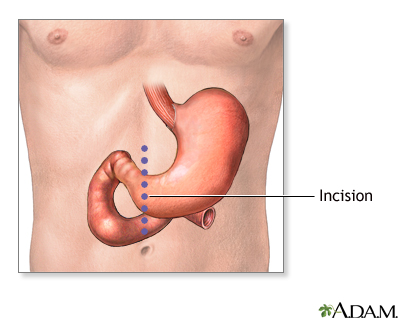Stomach cancer
Cancer - stomach; Gastric cancer; Gastric carcinoma; Adenocarcinoma of the stomach
Stomach cancer is cancer that starts in the stomach.
Causes
Several types of cancer can occur in the stomach. The most common type is called adenocarcinoma. It starts from one of the cell types found in the lining of the stomach.
Adenocarcinoma is a common cancer of the digestive tract. It is not very common in the United States. It is diagnosed much more often in people in eastern Asia, parts of South America, and eastern and central Europe. It occurs most often in men over age 40.
Cancer
Cancer is the uncontrolled growth of abnormal cells in the body. Cancerous cells are also called malignant cells.
The number of people in the United States who develop this cancer has decreased over the years. Experts think this decrease may be in part because people are eating less salted, cured, and smoked foods.
You are more likely to be diagnosed with gastric cancer if you:
- Have a diet low in fruits and vegetables
- Have a family history of gastric cancer
- Have an infection of the stomach by a bacteria called Helicobacter pylori
- Had a polyp (abnormal growth) larger than 2 centimeters in your stomach
-
Have inflammation and swelling of the stomach for a long time (chronic atrophic
gastritis
)
Gastritis
Gastritis occurs when the lining of the stomach becomes inflamed or swollen. Gastritis can last for only a short time (acute gastritis). It may als...
 ImageRead Article Now Book Mark Article
ImageRead Article Now Book Mark Article -
Have
pernicious anemia
(low number of red blood cells from intestines not properly absorbing vitamin B12)
Pernicious anemia
Anemia is a condition in which the body does not have enough healthy red blood cells. Red blood cells provide oxygen to body tissues. There are man...
 ImageRead Article Now Book Mark Article
ImageRead Article Now Book Mark Article - Smoke
Symptoms
Symptoms of stomach cancer may include any of the following:
- Abdominal fullness or pain, which may occur after a small meal
- Dark stools
- Difficulty swallowing, which becomes worse over time
- Excessive belching
- General decline in health
- Loss of appetite
- Nausea
-
Vomiting blood
Vomiting blood
Vomiting blood is regurgitating (throwing up) contents of the stomach that contains blood. Vomited blood may appear either a bright red or dark red c...
Read Article Now Book Mark Article - Weakness or fatigue
-
Weight loss
Weight loss
Unexplained weight loss is a decrease in body weight, when you did not try to lose the weight on your own. Many people gain and lose weight. Uninten...
Read Article Now Book Mark Article
Exams and Tests
Diagnosis is often delayed because symptoms may not occur in the early stages of the disease. And many of the symptoms do not specifically point to stomach cancer. So, people often self-treat symptoms that gastric cancer has in common with other, less serious, disorders (bloating, gas, heartburn, and fullness).
Tests that can help diagnose gastric cancer include:
-
Complete blood count
(CBC) to check for
anemia.
Complete blood count
A complete blood count (CBC) test measures the following:The number of red blood cells (RBC count)The number of white blood cells (WBC count)The tota...
 ImageRead Article Now Book Mark Article
ImageRead Article Now Book Mark ArticleAnemia.
Anemia is a condition in which the body does not have enough healthy red blood cells. Red blood cells provide oxygen to body tissues. Different type...
 ImageRead Article Now Book Mark Article
ImageRead Article Now Book Mark Article -
Esophagogastroduodenoscopy
(EGD) with
biopsy
to examine the stomach tissue. EGD involves putting a tiny camera down the esophagus (food tube) to look at the inside of the stomach.
Esophagogastroduodenoscopy
Esophagogastroduodenoscopy (EGD) is a test to examine the lining of the esophagus, stomach, and first part of the small intestine.
 ImageRead Article Now Book Mark Article
ImageRead Article Now Book Mark ArticleBiopsy
A biopsy is the removal of a small piece of tissue for laboratory examination.
Read Article Now Book Mark Article -
Stool test
to check for blood in the stools.
Stool test
The stool guaiac test looks for hidden (occult) blood in a stool sample. It can find blood even if you cannot see it yourself. It is the most commo...
 ImageRead Article Now Book Mark Article
ImageRead Article Now Book Mark Article
Treatment
Surgery to remove the stomach ( gastrectomy ) is the standard treatment that can cure adenocarcinoma of the stomach. Radiation therapy and chemotherapy may help. Chemotherapy and radiation therapy after surgery may improve the chance of a cure.
Gastrectomy
Gastrectomy is surgery to remove part or all of the stomach. If only part of the stomach is removed, it is called partial gastrectomyIf the whole sto...

Radiation therapy
Radiation therapy uses high-powered x-rays, particles, or radioactive seeds to kill cancer cells.

Chemotherapy
The term chemotherapy is used to describe cancer-killing drugs. Chemotherapy may be used to:Cure the cancerShrink the cancerPrevent the cancer from ...

For people who cannot have surgery, chemotherapy or radiation may improve symptoms and may prolong survival, but may not cure the cancer. For some people, a surgical bypass procedure may relieve symptoms.
Support Groups
You can ease the stress of illness by joining a cancer support group . Sharing with others who have common experiences and problems can help you not feel alone.
Cancer support group
The following organizations are good resources for information on cancer:American Cancer Society -- www. cancer. orgCancerCare -- www. cancercare. or...
Outlook (Prognosis)
Outlook varies based on how much the cancer has spread by the time of diagnosis. Tumors in the lower stomach are cured more often than those in the higher stomach. Chance of a cure also depends on how far the tumor has invaded the stomach wall and whether lymph nodes are involved.
When the tumor has spread outside the stomach, a cure is less likely. When a cure is not possible, the goal of treatment is to improve symptoms and prolong life.
When to Contact a Medical Professional
Call your health care provider if symptoms of gastric cancer develop.
Prevention
Screening programs are successful in detecting disease in the early stages in parts of the world where the risk of stomach cancer is much higher than in the United States. The value of screening in the United States and other countries with much lower rates of stomach cancer is not clear.
The following may help reduce your risk of stomach cancer:
- DO NOT smoke.
- Keep a healthy diet rich in fruits and vegetables.
-
Take medicines to treat
reflux disease (heartburn)
, if you have it.
Reflux disease (heartburn)
Gastroesophageal reflux disease (GERD) is a condition in which the stomach contents leak backwards from the stomach into the esophagus (the tube from...
 ImageRead Article Now Book Mark Article
ImageRead Article Now Book Mark Article - Take antibiotics if you are diagnosed with H pylori infection.
References
Abrams JA, Quante M. Adenocarcinoma of the stomach and other gastric tumors. In: Feldman M, Friedman LS, Brandt LJ, eds. Sleisenger and Fordtran's Gastrointestinal and Liver Disease: Pathophysiology/Diagnosis/Management . 10th ed. Philadelphia, PA: Elsevier Saunders; 2016:chap 54.
Gunderson LL, Donohue JH, Alberts SR. Ashman JB, Jaroszewski DE, eds. Cancer of the stomach and gastroesophageal junction. In: Niederhuber JE, Armitage JO, Doroshow JH, Kastan MB, Tepper JE, eds. Abeloff's Clinical Oncology . 5th ed. Philadelphia, PA: Elsevier Saunders; 2014:chap 75.
National Cancer Institute. Gastric cancer treatment (PDQ) - health professional version. Updated June 30, 2016. cancer.gov/cancertopics/pdq/treatment/gastric/HealthProfessional . Accessed December 21, 2016.
-
Digestive system - illustration
The esophagus, stomach, large and small intestine, aided by the liver, gallbladder and pancreas convert the nutritive components of food into energy and break down the non-nutritive components into waste to be excreted.
Digestive system
illustration
-
Stomach cancer, X-ray - illustration
An upper GI series in a patient with cancer of the stomach (gastric carcinoma).
Stomach cancer, X-ray
illustration
-
Stomach - illustration
The stomach is the portion of the digestive system most responsible for breaking down food. The lower esophageal sphincter at the top of the stomach regulates food passing from the esophagus into the stomach, and prevents the contents of the stomach from reentering the esophagus. The pyloric sphincter at the bottom of the stomach governs the passage of food out of the stomach into the small intestine.
Stomach
illustration
-
Gastrectomy - series
Presentation
-
Digestive system - illustration
The esophagus, stomach, large and small intestine, aided by the liver, gallbladder and pancreas convert the nutritive components of food into energy and break down the non-nutritive components into waste to be excreted.
Digestive system
illustration
-
Stomach cancer, X-ray - illustration
An upper GI series in a patient with cancer of the stomach (gastric carcinoma).
Stomach cancer, X-ray
illustration
-
Stomach - illustration
The stomach is the portion of the digestive system most responsible for breaking down food. The lower esophageal sphincter at the top of the stomach regulates food passing from the esophagus into the stomach, and prevents the contents of the stomach from reentering the esophagus. The pyloric sphincter at the bottom of the stomach governs the passage of food out of the stomach into the small intestine.
Stomach
illustration
-
Gastrectomy - series
Presentation
Review Date: 11/10/2016
Reviewed By: Todd Gersten, MD, Hematology/Oncology, Florida Cancer Specialists & Research Institute, Wellington, FL. Review provided by VeriMed Healthcare Network. Also reviewed by David Zieve, MD, MHA, Medical Director, Brenda Conaway, Editorial Director, and the A.D.A.M. Editorial team.









